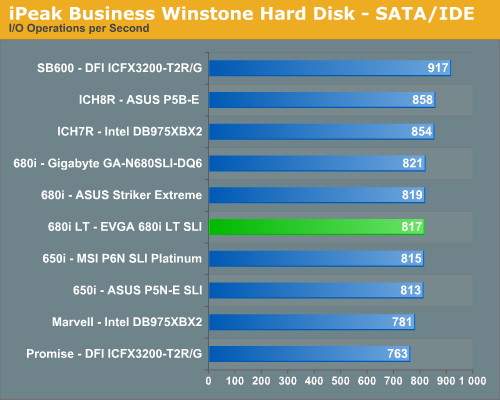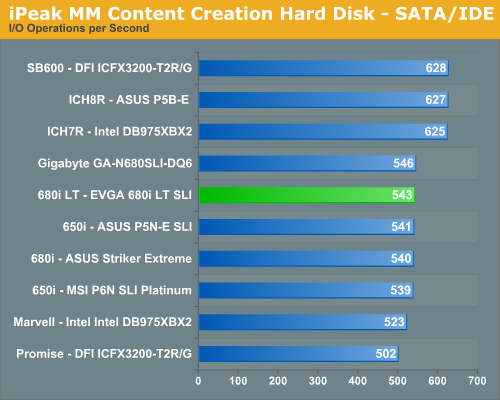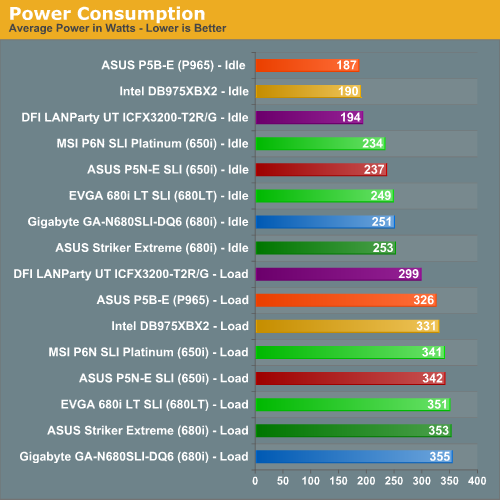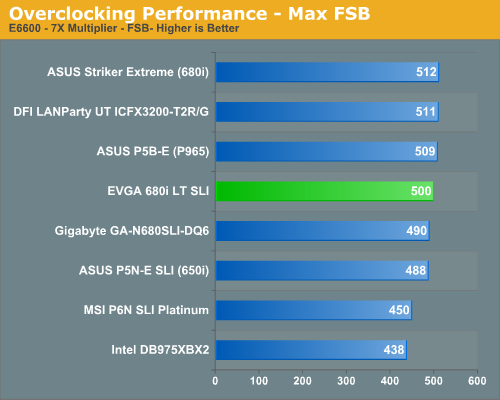EVGA 680i LT SLI: NVIDIA's 680i Cost Reduced
by Gary Key on March 28, 2007 4:00 AM EST- Posted in
- CPUs
Disk Controller Performance
The AnandTech iPeak test is designed to measure "pure" hard disk controller performance, and in this case, we keep the hard drive as consistent as possible while varying the hard drive controller. The idea is to measure the performance of each hard drive controller with the same hard drive.
We play back our raw files that are recorded I/O operations when running a real world benchmark - the entire Winstone 2004 suite. Intel's iPeak utility is then used to play back the trace file of all I/O operations that took place during a single run of Business Winstone 2004 and MCC Winstone 2004. The drive is formatted before each test run and a composite average of three tests on each controller interface is tabulated in order to ensure consistency in the benchmark.
iPeak gives a mean service time in milliseconds; in other words, the average time that each drive took to fulfill each I/O operation. In order to make the data more presentable, we report the scores as an average number of I/O operations per second so that higher scores translate into better performance. The resulting scores are useful for comparing "pure" performance of the storage controllers in this case.


The performance patterns hold steady across both Multimedia Content I/O and Business I/O with the SB600 outperforming the Intel ICH7R, Intel ICH8R, and NVIDIA 680i/650i chipsets in our non-RAID tests. The Promise controller on the DFI board is the slowest of all solutions with the Marvell controller on the Intel 975X performing only slightly better. The 680i and 650i MCP chipsets are different but their disk performance in our tests is similar. We also ran RAID 0 and RAID 5 tests on each controller with the results being in favor of the 680i MCP by around 2% over the 680i LT MCP in these particular benchmarks. Although our NVIDIA boards generally score lower in these "pure" throughput tests, we find their actual performance in disk intensive applications are generally equal to or better than the other solutions.
Power Consumption

Our power consumption numbers are based on our test setup for this article that consists of an MSI 8800GTX video card and our boards have C1E/EIST turned off. The 680i boards lead all in power consumption but the 680i LT SLI is close behind with the LT certainly not meaning Lite in the way of power consumption. The P965 consumes the least amount of power at idle but around 10% more than the RD600 at load. The 975X still offers a decent level of power conservation compared to the other chipsets even though it is getting long in the tooth.
Overclocking

As we mentioned earlier in the article, the overclocking capability of the EVGA board has been neutered to some degree by the limited voltages and options available in the BIOS. Maybe we were just unlucky with our processor choices but this board had enough FSB holes that we thought about using it to whip up a few Swiss cheese sandwiches. After speaking with NVIDIA, we expect the overclocking capabilities of this chipset to vary based upon the luck of the draw when purchasing a board. Of course this is true of any component but it will be interesting to see the results of this latest effort by NVIDIA once the boards are in the hands of owners.
We believe their target is for consistent performance in the 450FSB to 475FSB range and anything above that will be icing on the big green cake. This will be disappointing to users who end up with a board that performs lower than our retail box sample but overclocking is never guaranteed. We will be purchasing a retail board from Newegg shortly to compare against our current board and will update our results if they are significant. Considering that there's a good chance the 680i LT boards are simply using rejected 680i chipsets - chips that couldn't run at higher FSB settings - we would advise caution for anyone looking to get an optimal overclocking platform.
We also found that during overclocking we had to set our CPU voltages a little higher than on the other boards to attain the same or better overclocks. We experienced this with the MSI 650i board and it was generally due to tighter memory/chipset timings in order to improve the performance of the board at stock speeds. Overall, our overclocking experiences were very good and the results of our tests show a board that is still very capable although certainly less than what we believe it is capable of with an enthusiast level BIOS.
The AnandTech iPeak test is designed to measure "pure" hard disk controller performance, and in this case, we keep the hard drive as consistent as possible while varying the hard drive controller. The idea is to measure the performance of each hard drive controller with the same hard drive.
We play back our raw files that are recorded I/O operations when running a real world benchmark - the entire Winstone 2004 suite. Intel's iPeak utility is then used to play back the trace file of all I/O operations that took place during a single run of Business Winstone 2004 and MCC Winstone 2004. The drive is formatted before each test run and a composite average of three tests on each controller interface is tabulated in order to ensure consistency in the benchmark.
iPeak gives a mean service time in milliseconds; in other words, the average time that each drive took to fulfill each I/O operation. In order to make the data more presentable, we report the scores as an average number of I/O operations per second so that higher scores translate into better performance. The resulting scores are useful for comparing "pure" performance of the storage controllers in this case.


The performance patterns hold steady across both Multimedia Content I/O and Business I/O with the SB600 outperforming the Intel ICH7R, Intel ICH8R, and NVIDIA 680i/650i chipsets in our non-RAID tests. The Promise controller on the DFI board is the slowest of all solutions with the Marvell controller on the Intel 975X performing only slightly better. The 680i and 650i MCP chipsets are different but their disk performance in our tests is similar. We also ran RAID 0 and RAID 5 tests on each controller with the results being in favor of the 680i MCP by around 2% over the 680i LT MCP in these particular benchmarks. Although our NVIDIA boards generally score lower in these "pure" throughput tests, we find their actual performance in disk intensive applications are generally equal to or better than the other solutions.
Power Consumption

Our power consumption numbers are based on our test setup for this article that consists of an MSI 8800GTX video card and our boards have C1E/EIST turned off. The 680i boards lead all in power consumption but the 680i LT SLI is close behind with the LT certainly not meaning Lite in the way of power consumption. The P965 consumes the least amount of power at idle but around 10% more than the RD600 at load. The 975X still offers a decent level of power conservation compared to the other chipsets even though it is getting long in the tooth.
Overclocking

As we mentioned earlier in the article, the overclocking capability of the EVGA board has been neutered to some degree by the limited voltages and options available in the BIOS. Maybe we were just unlucky with our processor choices but this board had enough FSB holes that we thought about using it to whip up a few Swiss cheese sandwiches. After speaking with NVIDIA, we expect the overclocking capabilities of this chipset to vary based upon the luck of the draw when purchasing a board. Of course this is true of any component but it will be interesting to see the results of this latest effort by NVIDIA once the boards are in the hands of owners.
We believe their target is for consistent performance in the 450FSB to 475FSB range and anything above that will be icing on the big green cake. This will be disappointing to users who end up with a board that performs lower than our retail box sample but overclocking is never guaranteed. We will be purchasing a retail board from Newegg shortly to compare against our current board and will update our results if they are significant. Considering that there's a good chance the 680i LT boards are simply using rejected 680i chipsets - chips that couldn't run at higher FSB settings - we would advise caution for anyone looking to get an optimal overclocking platform.
We also found that during overclocking we had to set our CPU voltages a little higher than on the other boards to attain the same or better overclocks. We experienced this with the MSI 650i board and it was generally due to tighter memory/chipset timings in order to improve the performance of the board at stock speeds. Overall, our overclocking experiences were very good and the results of our tests show a board that is still very capable although certainly less than what we believe it is capable of with an enthusiast level BIOS.










16 Comments
View All Comments
MrWizard6600 - Thursday, March 29, 2007 - link
dont know the full details, but the newest P26 Bios from EVGA Removed LinkBoost support“LinkBoost was removed from nForce 680i SLI because it did not show significant demonstrable benefit in games. We had hoped newer games would take advantage of this additional bandwidth but this has not been the case. Please note that future BIOS upgrades will only remove the automatic overclocking component of LinkBoost. Users can still manually overclock the PCI-Express and HyperTransport buses in the BIOS."
SniperWulf - Wednesday, March 28, 2007 - link
Any chance I can get that registry key that you deleted after the nv4_disp crash?yacoub - Wednesday, March 28, 2007 - link
It's time to start recommending Supreme Commander to be the RTS game test choice. Now that there's a new RTS game that can crush systems (SupCom) the way FEAR did for FPS games for the last couple years, a game that makes use of multiple cores at that, we should start to see it used in the suite of games in future motherboard, cpu, and gpu tests. Perhaps Anandtech have already started planning for this?yyrkoon - Wednesday, March 28, 2007 - link
Well, it is not an RTS game, but one I play frequently should also be used to test gaming rigs in my humble opinon. Titan Quest (Immortal Throne if deemed nessisary).My gaming Rig is not top of the line, but it is no slouch, and this game constantly drags in areas that are low light areas, or are outside, and night time. Anyhow, and game that brings my opteron 1210 / ABIT NF-M2 nView / 2 GB DDR2 6400 memory, eVGA 7600GT KO to a crawl, SHOULD be used as a benchmark, at least once in a while. F.E.A.R does not lag like this game does on my system . . .
Stele - Wednesday, March 28, 2007 - link
I agree to an extent, as the current test suite's figures are starting to show their age a wee bit... 100+ FPS, as Quake ended up with newer CPUs/GPUs. Having said that, Anandtech was probably trying to ensure consistency in its tests, so that at the very least, past test results for other products can always be quite easily compared over time. Perhaps in the near future we might see it yet! :)JarredWalton - Wednesday, March 28, 2007 - link
I believe Gary is looking at benching with Supreme Commander. That's one of the games that will be added in future reviews, as far as I know.yacoub - Wednesday, March 28, 2007 - link
Awesome, glad to hear that! One can see the benefit to maintaining benchmark titles for as long as possible to allow the greatest comparison back to past reviews. On the up side, SupCom looks to easily task systems well into the future (much like FEAR has thus far since its release) and would be an excellent choice for the RTS benchmark game. :)yyrkoon - Wednesday, March 28, 2007 - link
Firstly, I have to get this out. It is a completely LAME excuse for nVidia, eVGA, Foxconn, or whomever, to 'claim' the reason this board does not have passive cooling (OTES or equivelent), is to help cut costs. 20 bux less, and they rip out passive cooling ? Lame. Take ABITs NF-M2 nView $85usd , including passive cooling, and moderate other features. Granted, it is based on the NF4 chipset, but who cares, it has passive cooling, and loads of other features for the price.I have to agree somewhat with the first poster, this board is dead, before it even reaches market. Crippled features, missing other features, all for to save $20-$50 usd. Sorry nVidia, and whomever else, but you have not only completely wasted your time, but ours as well, for having to read a review on such a shitty product.
yacoub - Wednesday, March 28, 2007 - link
very much agree. the passive cooling is (and should be) an integral feature of current generation motherboards. there's no reason ANY motherboard released today should require active northbridge (or southbridge) chipset cooling (unless you're overclocking, obviously).yyrkoon - Wednesday, March 28, 2007 - link
One thing I did keep wondering the whole time I was reading the article, and you were mentioning how the BIOS was basically a crippled version of the full blown i680 SLI version was: 'I wonder how soon someone would mod a BIOS version based on the i680 SLI chipset BIOS, to add removed 'features' such as certain voltage settings, etc.'Also, Jarred, or whomever else would like to answer, how hot does the PWM section of this motherboard run ? Seems lately, dual core on up motherboards tend to run hot in the PWM.